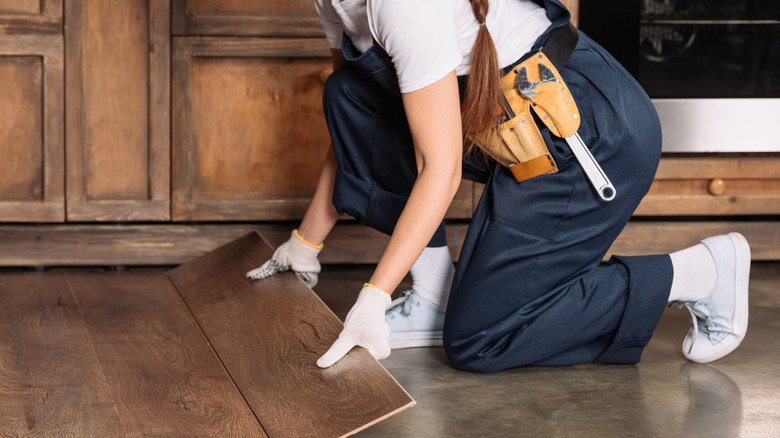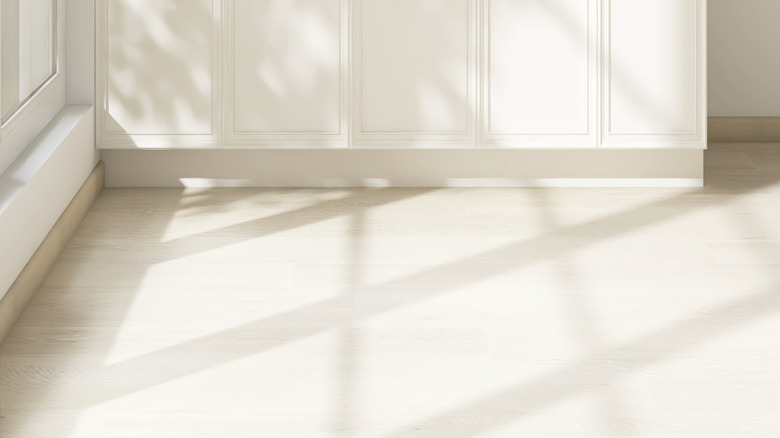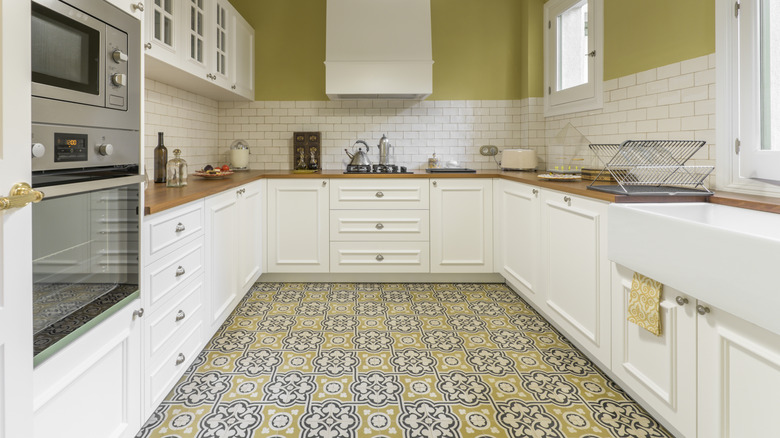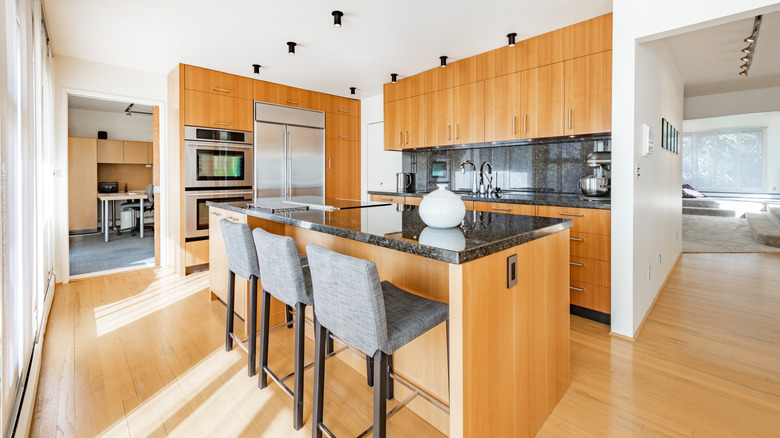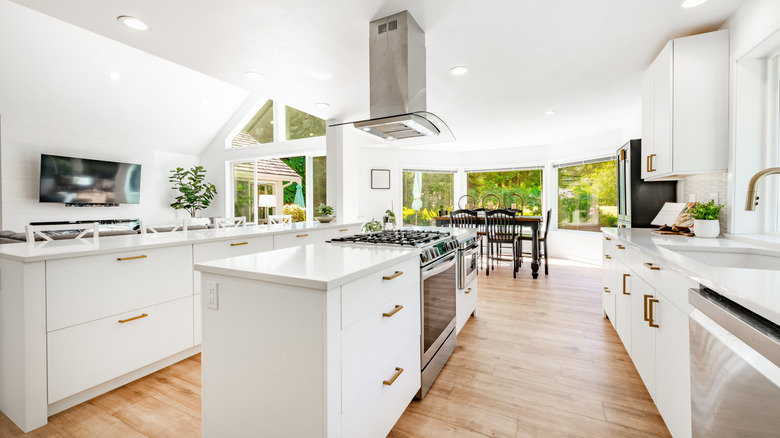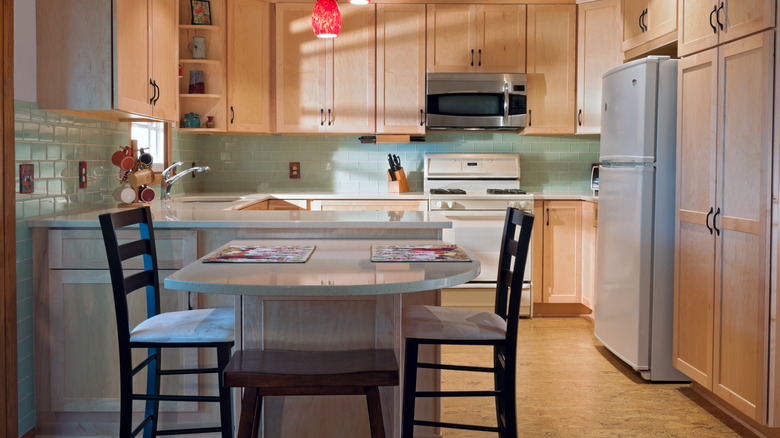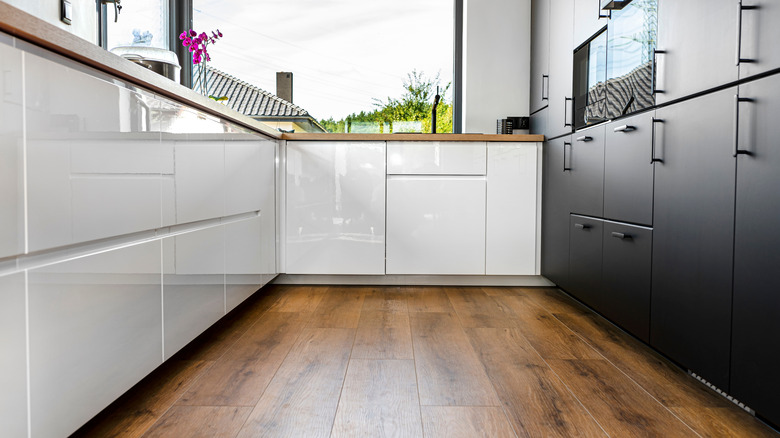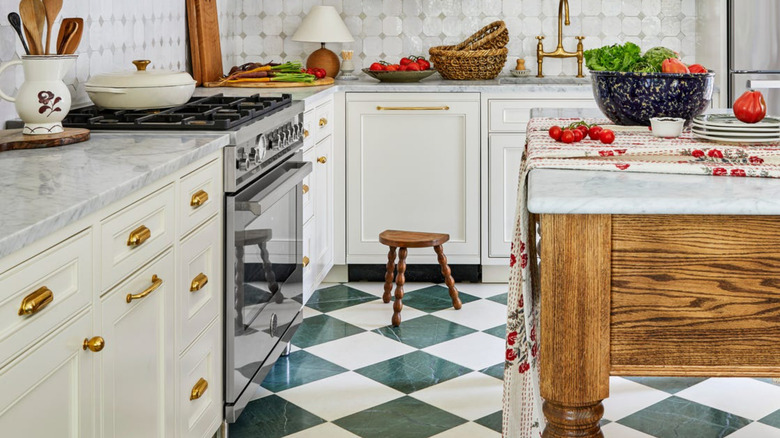9 Affordable Kitchen Floors You Can DIY (And How To Choose The Best)
We may receive a commission on purchases made from links.
Does your dream kitchen include an old-school black and white checkered floor? Have you fallen in love with the look of hardwood? Or have you been inspired to seek a more eco-friendly and sustainable solution for your space? No matter what you wish, you can make all your kitchen floor dreams come true with these affordable ideas you can DIY.
Think of us as your flooring fairy godmother. We've put together a list of awesome kitchen flooring options for you to choose from. When deciding what the best option is for you, first determine what factors are the most important. We'll break down each type of flooring by price, ease of installation, maintenance, and durability. Then, only you can decide if the shoe fits. Keep reading for 11 DIY-able, affordable kitchen floors to choose from.
Laminate flooring is a very budget-friendly option
Starting at about $1 to $3 per square foot, laminate flooring is a low-cost kitchen flooring option. Laminate is made up of multiple layers that are fused by heat and pressure. Similar to vinyl flooring, laminate comes in a variety of patterns, textures, and styles. For example, laminate can look like hardwood or stone, or have elaborate designs.
Even inexperienced DIYers can successfully tackle laminate installation, because they typically include a tongue-and-groove system. There is no glue-down required, so the laminate serves as a floating floor. Cleaning and maintaining laminate flooring is pretty basic; all you need is a vacuum, dry mop, or broom. However, it's crucial to avoid mistakes when cleaning your laminate floors, as they are susceptible to warping if exposed to too much moisture. Because of laminate's make-up, it is generally a durable and scratch-resistant material. If budget is your number one consideration when choosing a kitchen floor, laminate is an ideal choice.
Peel-and-stick vinyl tiles streamline installation
Peel-and-stick vinyl tiles are a hassle-free, budget-friendly kitchen flooring option. These tiles range from around $1 to $5 per square foot, making them one of the most affordable choices for kitchen flooring. They come in a huge variety of styles, from mimicking stone or hardwood to vibrant patterns and colors. Options like FloorPops x Chris Loves Julia Bonneville Peel-and-Stick Floor Tiles come in designs that look like marble tile. The manufacturer also makes Blue Ezra Vinyl Peel-and-Stick Floor Tiles that feature a graphic design.
You can truly change your floor in a flash with peel-and-stick tiles. Installation for peel-and-stick vinyl tiles is pretty self-explanatory. Just peel off the backing and stick the tile to the floor. It's a good idea to give your floors a clean before applying these tiles, but otherwise, there is no special preparation needed. Vinyl tiles are also easy to maintain, requiring a quick sweep or mop to keep them clean. They are also durable and waterproof. If budget, design creativity, and ease of installation are key factors for your kitchen flooring, these tiles are a great option.
Painted floors offer unlimited customization
Painting your kitchen floors is actually a really budget-friendly way to upgrade the whole space. Depending on the cost of materials (like a sander, primer, and paint), you can paint your wood floors for about $2 to $4 per square foot. A major benefit of painted floors is the creative freedom. Whether you want to try out a funky color pattern or stick with a solid color, the sky is truly the limit when it comes to painting your floors.
Generally, this project is super easy to do (anyone can paint, right?). But there are a few things to know before painting your floors. First, if you're painting over wood or tile, you need to sand off the existing stain or paint and then thoroughly clean the surface. Before you get painting, be sure to properly ventilate your space. Then choose the appropriate primer for your existing floors, and pick your paint. Epoxy paint is a great option, and enamel paint is good for wood floors. This White Satin Paint from Glidden has primer included in the formula and can be used on everything from wood to concrete. And, Rustoleum's Floor Coating Topcoat allows you to transform everything from vinyl and ceramic tile to hardwood. Overall, painted floors can last a few years, and can be cleaned with a vacuum or broom (avoid super wet mops). If you're really into design freedom, painting your floors is absolutely the way to go. But it's not the most durable, long-lasting option.
Ceramic tile combines affordability and durability
Looking for that classic, retro white and black floor? Or, do you want your kitchen floors to have a stone-like look? Ceramic tile may be your best bet! At around or below $5 per square foot, it's an affordable choice for your kitchen floor. Additionally, ceramic tile is slightly cheaper than porcelain tile, making it a budget-friendly option. Ceramic tile is made from natural clay and can come in either a glazed or unglazed finish. From solid tiles mixed to create unique patterns to very detailed, colorful tiles, this is a versatile flooring option.
Now, ceramic tile can be tricky to install. So if you're not a seasoned DIYer, there are a few things to consider. First, go for a glazed finished tile (this way, you don't need a sealant). You'll want to avoid tricky tiles, like very large or very small formats, and instead choose easy-to-manage sizes or tile sheets. To install, ensure you have a proper tile backer to adhere the tiles to, and fill the gaps between tiles with grout. The Pre-Mixed Grout from Red Devil is a convenient option that eliminates a step. Even though installation is a bit more challenging, ceramic tiles are extremely durable and one of the easiest flooring materials to maintain. It's even considered one of the best tiles for your kitchen floor. So if you're willing to put in a little more work, ceramic tile is an affordable, long-lasting choice.
Bamboo flooring offers sustainability at a reasonable price point
Bamboo is a fast-growing plant that's ready to harvest in as little as five years. This makes it a super sustainable and eco-friendly material for kitchen flooring. At about $2 to $8 per square foot, it's also an affordable option. Bamboo has an appearance very similar to hardwood, but is often more cost-efficient. So, it's considered a great alternative for hardwood in your kitchen. Bamboo's natural color is a light, honey tone, but it's also available in darker tones.
There are a few different types of installation methods for bamboo. The floating floor installation is the easiest DIY, as the bamboo planks connect with a click-lock system and do not attach to the subfloor. Nail-down and glue-down installations require a little more skill and effort. Similar to hardwood, bamboo is durable and long-lasting. It's easy to maintain by sweeping, vacuuming, or using a damp mop. If sustainability is your jam, this is definitely a material to consider.
Refinish existing hardwood floors for a new look at a low cost
Okay, what if you already love your hardwood kitchen floors, but they need a little revamp? That's when refinishing comes in. It typically costs $3 to $8 per square foot to have your hardwood floors refinished. However, you can buy all of the tools and supplies to DIY the project for as little as $500. So, if you have the skills, this could be an affordable option, especially if you have a large area. There are a ton of choices when it comes to hardwood floor stains, so the finished look is highly customizable.
It's absolutely possible to refinish your hardwood floors yourself, but it can be a time-consuming process. The process consists of cleaning the floor, sanding, fixing any damage (like deep gaps or scratches), staining, and adding a top coat. There are some key tips for refinishing hardwood floors: don't skip the safety equipment, label your molding, and stock up on more sandpaper than you think you'll need. With all that being said, refinished hardwood floors are durable and easy to clean. If you're not looking for a major change or upgrade, and your hardwood floors just need a makeover, refinishing them is a good option.
Cork flooring is a unique kitchen flooring choice
Cork may seem like an unlikely flooring option for your kitchen, but it's surprisingly popular. On average, cork flooring is $3 to $9 per square foot. It's a natural material that comes from the cork oak tree. The cork is ground and then pressed into sheets or planks to create simple-to-install flooring. The material is soft, comfortable underfoot, and eco-friendly. Now compared to other flooring options, design-wise, there isn't a lot of versatility in cork.
There are a few different kinds of cork flooring, but sealed cork planks are among the most DIY-friendly. These planks have interlocking edges to make for easy installation. Glue-down cork flooring is the other option, a little more complicated but is still relatively easy to accomplish. One thing to note: if you don't choose a sealed cork (or prefinished cork) you will have to add multiple coats of sealant after installing. Cork flooring is durable, and can be cleaned by a broom or vacuum. But don't use a sopping wet mop. Like laminate, cork can be susceptible to damage. It is also prone to fading if consistently in direct sunlight. In short, cork is a gorgeous, budget-friendly kitchen flooring option in the right circumstances.
Vinyl planks include a wide range of options
Vinyl planks are another awesome, budget-friendly kitchen flooring option. The price of vinyl planks can vary. Standard planks can be as low as $2, and luxury plank options can cost up to $10 a square foot. Vinyl planks commonly mimic hardwood or stone. Standard vinyl planks have multiple layers of printed vinyl and a rigid core, and luxury planks have a thicker top coating with a more realistic texture.
The most DIY-friendly vinyl planks are click-together. These planks lock into one another, creating a floating floor. There are also peel-and-stick planks or glue-down options. The glue-down options are more labor-heavy, but offer the most durability. Overall, vinyl planks are easy to clean, waterproof, and relatively scratch-resistant. They're also a great kitchen flooring option if you want to achieve a high-end look for less.
Linoleum flooring is a versatile choice
Before you start saying that linoleum is old-school and outdated, let us give you the lowdown. Linoleum ranges from $3 to $12 per square foot, and it's eco-friendly. It's made from natural materials like linseed oil, cork, and more, then combined with resin and pressed. Fun fact: Linoleum was invented in 1860. There has to be a reason it's been popular for so long, right? You can use linoleum for any kitchen design style as it's available in a range of colors and patterns.
Click-together linoleum planks are considered the most DIY-friendly option. Simply attach planks with the tongue-and-groove system; no adhesive is needed. There are also linoleum tiles and sheet linoleum that require gluing down. Linoleum is durable and long-lasting, and generally easy to maintain. It is water-resistant, not waterproof, so be sure to quickly clean up spills and don't use a very wet mop. Don't sleep on linoleum, as it's a design-friendly and low-maintenance flooring option.
